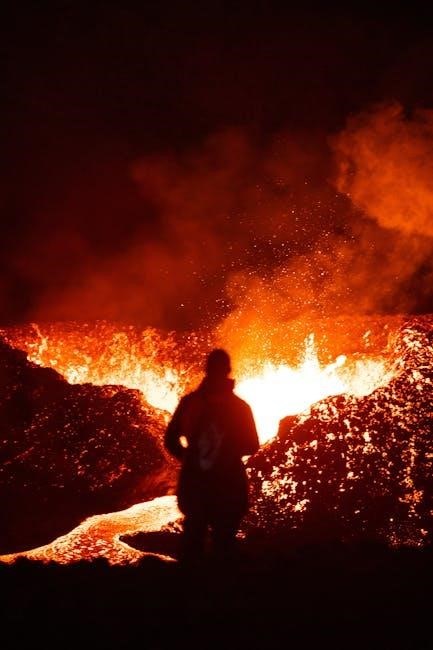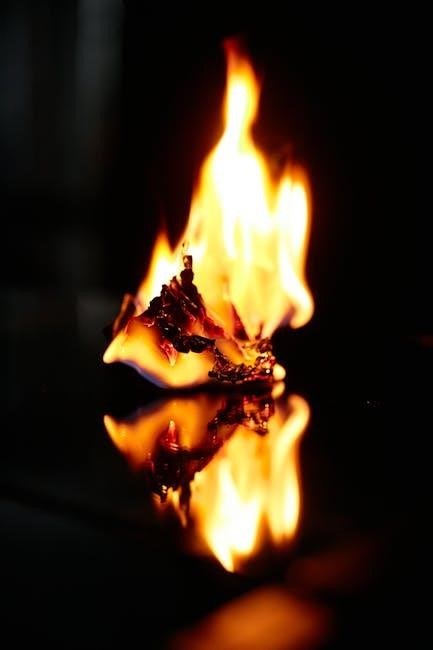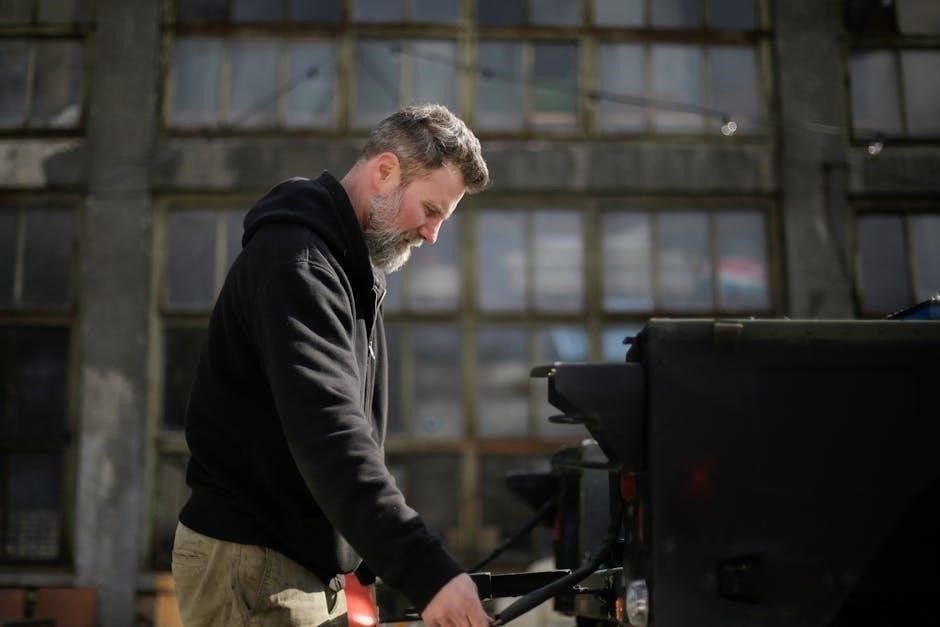Welcome to the HTVRONT Heat Press Temperature Guide, your comprehensive resource for mastering heat press settings. This guide covers temperature ranges, material-specific settings, and troubleshooting tips to ensure optimal results for various crafting projects, helping you achieve professional-quality transfers every time.
Overview of HTVRONT Heat Press Capabilities
The HTVRONT Heat Press is a versatile tool designed for a wide range of heat transfer applications. It offers a temperature range of 100°F to 356°F, making it suitable for materials like HTV, sublimation paper, and more. The machine is known for its durability, portability, and user-friendly interface, catering to both beginners and experienced crafters. Its robust design ensures consistent heat distribution, enabling precise control over transfers for professional-quality results across various substrates, from fabrics to ceramics and beyond.
Understanding the Temperature Range of HTVRONT Heat Press
The HTVRONT Heat Press operates between 100°F and 356°F, accommodating various materials like HTV, sublimation paper, and more, ensuring precise temperature control for diverse crafting needs.
Minimum and Maximum Temperature Settings
The HTVRONT Heat Press features a temperature range of 100°F to 356°F, allowing for precise control. The minimum setting of 100°F is ideal for delicate materials, while the maximum of 356°F is suitable for thick or dense substrates. Properly adjusting these extremes ensures optimal results, preventing damage to materials or press components. Always consult the user manual or manufacturer guidelines for specific recommendations tailored to your project needs.
Importance of Temperature Control for Different Materials
Temperature control is crucial for achieving optimal results with the HTVRONT Heat Press. Different materials, such as HTV, sublimation paper, and fabric, require specific temperature settings to ensure proper adhesion, color vibrancy, and durability. Incorrect temperatures can lead to issues like scorching, peeling, or incomplete transfers. By understanding the ideal temperature range for your material—typically between 100°F and 356°F—you can avoid damage and ensure a professional finish for your projects.

Optimal Temperature Settings for HTV (Heat Transfer Vinyl)
The optimal temperature for HTV ranges between 305-320°F (152-160°C), depending on the type and brand. For standard HTV, 315°F is ideal for vibrant, lasting results.
General Guidelines for HTV Temperature and Time
For most HTV applications, a temperature range of 305-320°F (152-160°C) is recommended, with press time typically between 10-15 seconds; Pressure should be firm but not excessive. Thicker fabrics may require higher temperatures, while delicate materials need lower settings. Ensure the heat press is preheated correctly, and always peel the vinyl hot for optimal adhesion. Adjustments may be necessary based on specific vinyl types and fabric combinations.
Manufacturer Recommendations for Specific HTV Types
Manufacturer guidelines vary for different HTV types. Standard HTV typically requires 305-320°F (152-160°C) for 10-15 seconds. Glitter and metallic HTV may need higher temperatures, around 320-340°F (160-170°C), for 15-20 seconds; Reflective HTV often requires lower temperatures, 295-305°F (146-150°C), with shorter press times of 8-12 seconds. Always consult the specific HTV manufacturer’s instructions for precise settings, as variations exist between brands and specialty vinyls.

Temperature and Time Settings for Specific Materials
Temperature and time settings vary by material, with sublimation paper and transfer paper requiring lower temps, while air fresheners and puzzles need higher settings for optimal results.
Sublimation Paper and Transfer Paper Settings
For sublimation paper and transfer paper, optimal results are achieved at 385-400°F (196-204°C) for 40-60 seconds. Medium pressure is recommended to ensure even heat distribution. Higher temperatures can burn the ink, so precise settings are crucial. These parameters ensure vibrant, long-lasting transfers on materials like ceramic, glass, and fabric. Always refer to the manufacturer’s guidelines for specific paper types to avoid over-pressing and achieve professional-quality sublimation results consistently.
Settings for Air Fresheners, Puzzles, and Other Unique Items
Air fresheners and puzzles require specific heat press settings for optimal results. Set the temperature between 350-400°F (177-204°C) and press for 45-60 seconds with medium pressure. For air fresheners, ensure the entire item is under the heat plate; Puzzles should retain their cardboard backing to maintain shape. These settings ensure proper ink adhesion without scorching, making them ideal for unique or irregularly shaped items. Adjustments may vary based on material thickness and design complexity for the best outcome.
Factors Influencing Heat Press Temperature and Time
Material thickness and type significantly influence temperature and time settings. Thicker materials may require higher temperatures and longer press times for proper adhesion and durability.
Material Thickness and Type
Material thickness and type play a crucial role in determining heat press settings. Thicker materials, such as heavy fabrics or ceramic items, often require higher temperatures and longer press times to ensure proper adhesion. Conversely, thinner materials like sublimation paper or lightweight HTV may need lower temperatures to prevent scorching. The type of material, whether it’s fabric, glass, or plastic, also influences optimal temperature and time settings, as different substrates react differently to heat and pressure.
Pressure and Heat Distribution
Proper pressure and heat distribution are essential for achieving even transfers. The HTVRONT heat press ensures uniform heat distribution across the platen, preventing hotspots and scorching. Adjusting pressure according to material thickness is crucial—too little may result in incomplete adhesion, while too much can damage substrates. Ensure the item is snug on the platen and evenly pressed. Proper alignment and preheating also contribute to consistent results, making pressure and heat distribution key factors in successful heat pressing applications.

Using the HTVRONT Auto Tumbler Heat Press Machine
The HTVRONT Auto Tumbler Heat Press Machine is a versatile tool designed for sublimation on mugs and tumblers, offering precise temperature control and even heat distribution for professional results.
Specific Temperature and Time Settings for Mugs and Tumblers
For sublimation on mugs and tumblers, the HTVRONT Auto Tumbler Heat Press Machine recommends settings of 385-400°F (196-204°C) for 40-60 seconds. For full wraps, press for 60-90 seconds, then rotate the tumbler 180 degrees and press again for another 60-90 seconds. Ensure even heat distribution by centering the design and using the appropriate platen size. Always preheat the press and refer to the user manual for material-specific adjustments to achieve vibrant, long-lasting results.
Best Practices for Sublimation on Ceramic and Glass
For successful sublimation on ceramic and glass, ensure surfaces are clean and dry to prevent imperfections. Use high-quality sublimation ink and paper designed for these materials. Preheat the press to 385-400°F (196-204°C) and apply medium pressure. Allow items to cool completely before handling to avoid cracking. Always mirror designs before printing and ensure proper alignment. Regularly maintain your press to prevent ink residue buildup. Follow these steps to achieve vibrant, durable sublimation results on ceramic and glass items.

Troubleshooting Common Heat Press Issues
Common issues like scorching or peeling can occur due to incorrect temperature or time settings. Adjusting these parameters and ensuring proper material preparation often resolves these problems effectively.
Adjusting Temperature for Optimal Results
Scorching or peeling issues often arise from incorrect temperature settings. For HTV, temperatures between 305-320°F are typically ideal, but always refer to the manufacturer’s guidelines for specific materials. Excessive heat can damage designs, while too little may result in poor adhesion. Adjusting in small increments and testing on scrap material can help find the perfect balance. Ensure pressure and time settings align with temperature adjustments for consistent, professional-quality results.
Fixing Common Problems Like Scorching or Peeling
Scorching and peeling are common issues that can arise from incorrect temperature or time settings. To fix scorching, reduce the temperature by 10-20°F and shorten the pressing time. For peeling, ensure the material is compatible with the heat press and increase the temperature slightly. Always preheat the press and substrate, and avoid over pressing. Using a heat-resistant parchment paper can also prevent scorching. Refer to the manufacturer’s guidelines for specific material adjustments to achieve flawless transfers.

Creating a Heat Press Temperature Cheat Sheet
A heat press temperature cheat sheet simplifies crafting by listing key settings for materials like HTV, sublimation paper, and more. Create one for quick, handy reference.
Practical Tips for Quick Reference
For quick reference, list material types, optimal temperatures, and press times. Include HTV (305-320°F, 10-15 sec), sublimation paper (385°F, 40-60 sec), and mug settings (350°F, 5-7 min). Note pressure levels and preheating times. Use a laminated chart for durability in workshop environments. Organize by material category for easy access. Update regularly as you discover new settings. Pair with the Cricut Heat app for real-time guidance. This cheat sheet becomes your go-to for consistent, professional results.
Customizing Settings for Frequently Used Materials
Customize your heat press settings based on the materials you use most. For HTV, store standard temps (305-320°F) and times (10-15 sec). Sublimation paper requires higher temps (385°F, 40-60 sec). Mugs and tumblers need 350°F for 5-7 min. Air fresheners and puzzles use 350-400°F for 45-60 sec. Create a personalized chart with these settings, ensuring quick access. Adjust pressure and time as needed for thickness or delicate surfaces. Regularly updating your settings ensures consistent results for your most common projects.
Mastering the HTVRONT heat press temperature guide ensures optimal results for HTV, sublimation, and unique materials. Adjust settings based on material type and thickness for professional finishes.
Final Thoughts on Mastering HTVRONT Heat Press Settings
Mastering HTVRONT heat press settings requires understanding temperature, time, and material-specific needs. By following guidelines and adjusting for unique projects, you can achieve flawless transfers; Always refer to manufacturer recommendations and create a cheat sheet for quick reference. Experimentation and patience will refine your skills, ensuring professional-quality results for HTV, sublimation, and beyond. Happy crafting!



0 Comments